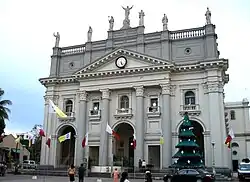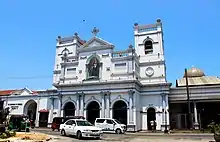Catholic Church in Sri Lanka
The Catholic Church in Sri Lanka is part of the worldwide Catholic Church, under the spiritual leadership of the pope in Rome. The country comes under the province of Colombo and is made up of 12 dioceses including one archdiocese. There are approximately 1.2 million Catholics in Sri Lanka representing around 6.1% of the total population (according to the 2012 census).[2] Later estimates suggest that there are over 1.6 million in 2020.[3][4]
 Official Catholic Church flag. Include the Anuradhapura cross. | |
| Total population | |
|---|---|
| Regions with significant populations | |
| Province | |
| Religions | |
| Catholicism | |
| Languages | |
| Part of a series on the |
| Catholic Church by country |
|---|
.svg.png.webp) |
|
|
In 1995, at a ceremony in Colombo, Pope John Paul II beatified Father Joseph Vaz (originally, José Vaz), an early Goan missionary to the country, who is known as the Apostle of Sri Lanka. On 17 September 2014, Pope Francis approved the vote to have him declared a saint.[5] Pope Francis canonized Father Joseph Vaz on Galle Face Green, in Colombo on 14 January 2015.[6]
Early history
Records of ancient travelers to Sri Lanka report that a separate area was allocated for Christians in the ancient capital Anuradhapura and there was a Christian chapel used by the Persian merchants who came to Ceylon in around the 5th century.[7] The Persian cross excavated in Anuradhapura belonging to the 5th century and the decorative baptismal pond excavated near Vavuniya prove the presence of Christians in Sri Lanka during the early period of the Anuradhapura Kingdom. Two crosses excavated around Anuradhapura in 1913 are said to be identical to the cross at St Thomas Mount near Chennai.[8]
Modern history
On 15 November 1505 a Portuguese fleet commanded by Lourenço de Almeida, having been driven by a storm to the shores of Sri Lanka, landed in Colombo. With the permission of the king of Kotte, Dharma Parakramabahu IX, Almeida erected a trade station and a small chapel in Colombo. The chapel was dedicated to St Lawrence. Franciscan Friar Vicente, the chaplain of the fleet, celebrated Mass. This is the first record of a Catholic Mass on Sri Lankan soil. Over the next few centuries, Portuguese, Dutch, and Irish missionaries spread the religion in Sri Lanka, most notably on the western and northwestern coast, where in some places Catholics are half the population.
2019 Easter bombings
On 21 April 2019, Easter Sunday, three churches in Sri Lanka and three luxury hotels in the commercial capital, Colombo, were targeted in a series of coordinated Islamist terrorist suicide bombings. Later that day, there were smaller explosions at a housing complex in Dematagoda and a guest house in Dehiwala. A total of 269 people were killed,[9] including at least 45 foreign nationals,[10] three police officers, and eight bombers, and at least 500 were injured. The church bombings were carried out during Easter services in Negombo, Batticaloa and Colombo; the hotels that were bombed were the Shangri-La, Cinnamon Grand, Kingsbury[11] and Tropical Inn. According to the State Intelligence Service, a second wave of attacks was planned, but was stopped as a result of government raids.[12]
The attack deeply shook the Christian and Catholic community of Sri Lanka, and Cardinal Malcolm Ranjith spent the next years asking for clarity and answers regarding responsibility for the bombings, and justice for the victims. Ranjith has been very critical of the investigations, alleging possible collusion of the Government with the attackers, citing a Parliamentary Select Committee report to this effect.[13]
The cardinal denies that the Church suffers persecution in Sri Lanka, saying there is a problem with human rights. "The Church is not under threat in Sri Lanka, but human rights are. In Sri Lanka, we are witnessing a struggle between the Sri Lankan population against the Government. The Government has mismanaged the economy and now we have many families without food. There is extreme poverty, and we want also to speak about this phenomenon so that the international community can help us, and not support this type of dictatorial government that does not respect human rights".[14]
Important churches
Cathedral

| Dioceses | Church | Type | Town |
|---|---|---|---|
| Anuradhapura | St. Joseph's Cathedral, Anuradhapura | Cathedral | Anuradhapura |
| Badulla | St. Mary’s Cathedral | Cathedral | Badulla |
| Batticaloa | St. Mary's Cathedral | Cathedral | Batticaloa |
| Chilaw | St. Mary's Cathedral, Chilaw | Cathedral | Chilaw |
| Colombo | St. Lucia's Cathedral | Cathedral & seat of the Archbishop | Colombo |
| Galle | St. Mary’s Cathedral | Cathedral | Galle |
| Jaffna | St. Mary’s Cathedral | Cathedral | Jaffna |
| Kandy | St. Anthony's Cathedral, Kandy | Cathedral | Kandy |
| Kurunegala | St. Anne's Cathedral, Kurunegala | Cathedral | Kurunegala |
| Mannar | St. Sebastian’s Cathedral | Cathedral | Mannar |
| Ratnapura | St. Peter and Paul Cathedral, Ratnapura | Cathedral | Ratnapura |
| Trincomalee | St. Mary's Cathedral, Trincomalee | Cathedral | Trincomalee |
National Shrines
| Dioceses | Church | Type | Town |
|---|---|---|---|
| Colombo | Basilica of Our Lady of Lanka | Shrine & Basilica | Ragama |
| Colombo | St. Anthony’s National Shrine | Shrine & minor Basilica | Colombo |
| Matara | Shrine of Our Lady of Matara | Shrine | Matara |
| Mannar | Shrine of Our Lady of Madhu | Shrine | Madhu |
| Kandy | St. Anthony's Church, Wahakotte | Shrine | Wahakotte |
See also
Notes
- "A3 : Population by religion according to districts, 2012". Census of Population & Housing, 2011. Department of Census & Statistics, Sri Lanka.
- "Census of Population and Housing 2011". www.statistics.gov.lk.
- World Religions Database at the ARDA website, retrieved 2023-08-08
- Catholics and Culture website, retrieved 2023-08-08
- Zenit News Agency Article
- National Catholic Register website, article dated January 14, 2015
- "Chapter X". lakdiva.org.
- Christmas yesteryear Archived 2007-09-30 at the Wayback Machine Daily News (Sri Lanka) Article
- "Sri Lanka attacks: Easter Sunday bombings marked one year on". BBC News. 2020-04-21. Retrieved 2022-11-08.
- "US Official, Injured In Sri Lanka Suicide Attack, Dies In Hospital". NDTV.com. Retrieved 2022-11-08.
- Moment of explosion at Sri Lanka's Kingsbury Hotel caught on CCTV, retrieved 2022-11-08
- "Failure of NTJ's second spate of orchestrated attacks - News Features | Daily Mirror". www.dailymirror.lk. Retrieved 2022-11-08.
- "Cardinal Ranjith stresses political involvement behind Sri Lanka Easter bombings - Vatican News". www.vaticannews.va. 2022-03-21. Retrieved 2022-11-08.
- "Sri Lanka: Victims of Easter bombings ask the Pope to help them uncover the truth". ACN International. 2022-04-26. Retrieved 2022-11-08.
References
External links
- The Catholic Church in Sri Lanka by GCatholic.org
- Profile of the Catholic church in Sri Lanka
- Herbermann, Charles, ed. (1913). . Catholic Encyclopedia. New York: Robert Appleton Company.
